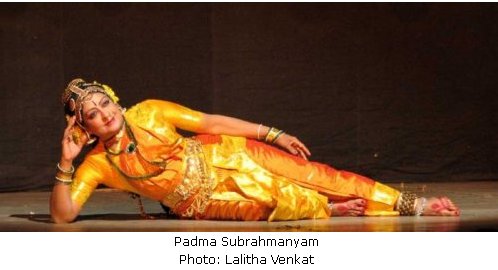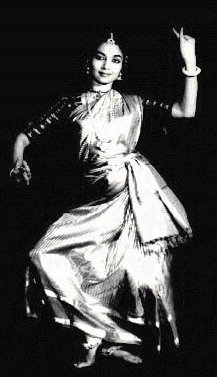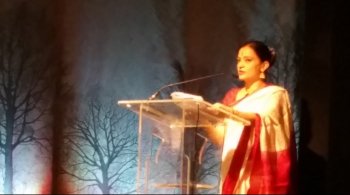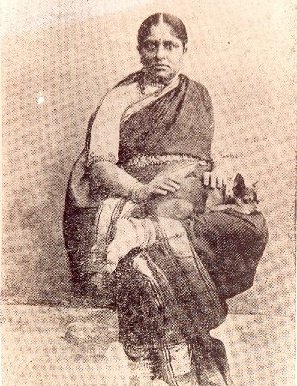
|   |

|   |
February 1, 2016  It is the season for "Paddu Akka" all over again. Padma Subrahmanyam is being featured on two magazine covers in the same month. DRISHTI, an initiative of dancer Anuradha Vikranth and NARTANAM edited by scholar Madhavi Puranam. Finally, a long overdue assessment has begun of Paddu Akka’s pedagogy, scholarship, costume innovations, choreographic and musical imprints, solo dance theatre inventions of BHARATA NRITYAM and finally her ambitious vision for BIFAC- Bharata Ilango Foundation for Asian Art and Culture, a centre outside Chennai. At 75, this compelling dancer-actor continues to win audiences in the various avenues she continues to explore.  A generation before her was the dance maker, iconoclast and pioneering genius MRINALINI SARABHAI. Her final breath, at age 97, was heard around the world. With her passing on January 21, 2016 several generations of dancers and scholars felt bereaved. Her brilliance seemed to have no limits. Choreography, writing, poems, environment, women’s rights, scientific enquiry- the questions were endless and the themes were poured into choreography. Daughter Mallika Sarabhai wrote on her Facebook page, “My mother has just left for her eternal dance,” thus announcing Mrinalini “Amma’s” moment of transition. At her funeral Mallika performed the beloved song KRISHNA NEE BEGANE, a favorite of Mrinalini “Amma”. Accolades continue to pour in from across the globe, with an overwhelming accumulation of personal memoirs and anecdotal recollections of how she influenced thousands and thousands through her dance and ideas. This portal was honored to have featured her column ASK MRINALINI for 7 years. Until she was no longer able to, Amma patiently answered all the questions, no matter how banal or trivial. This month we feature some archival questions / answers from the past. Mrinalini Sarabhai- what a life! What an artiste! At 97, she had seen so much. But most importantly, the birth of a nation, 15 Prime Ministers, 13 Presidents, the infamous Emergency in 1975 and numerous changes of government. Still, the artiste continued her journey… creating, sharing, performing, inspiring and educating. For me, born in the generation of the 1950s, Mrinalini Sarabhai will be the sole dancer responsible for inspiring and opening the doors to the intellectual possibilities of what Bharatanatyam and classical dance COULD BE. Her seminal book UNDERSTANDING BHARATANATYAM was the first handbook for an English speaking generation of young Indians seeking to probe deeper into the myriad layers of the form. I share my personal tribute to this iconic artiste.  Mrinalini Sarabhai, Dalai Lama, Mallika Sarabhai This edition will also carry other tributes as well as a documentary produced by Mallika which has recreated many of Amma’s path breaking dances on important social issues. With interviews and reflections by Mrinalini herself, this film is an essential part of dance history. Mrinalini was born in my hometown and her early years were shaped by the city’s bristling spirit of independent ferment. How the scene has changed since! She, along with Rukmini Devi, did so much to encourage young women in the 1940s and 1950s to learn this classical art form. However, for me it was Kumari Kamala Lakshman and Yamini Krishnamurthy who were the catalysts to spark my dance journey. When it was announced that Yamini Akka had been awarded the PADMA VIBHUSHAN by the Indian Government, Bharatanatyam dancers across the globe felt elated. If only a good documentary was made on Yamini in her prime. What fire! What passion! What energy! All that we speak about today- athleticism, speed and vigour was packaged into her dynamic frame! I recall my guru Adyar K Lakshman, her senior in Kalakshetra, conducting the daily mammoth rehearsal sessions. The arduous Khamas varnam ENTA NINNE would be rehearsed FIVE TIMES NON STOP until Lakshman Sir, the vocalist and mridangist almost fell into a swoon! Such was her stamina!  Yamini Krishnamurthy When she performed the famous Kuchipudi KRISHNA SABDAM in Paris and it came to the saucy “RA RA” section in which Bhama invites Krishna to come to her, audience members actually ran up onto the stage thinking Yamini was calling them! Yamini’s dedication and endless energy were cited to me repeatedly when I would complain about fatigue in Lakshman Sir’s classes! With Pratibha Prahlad’s name also on the PADMA SHRI list, it is a good moment for Bharatanatyam. Never mind that no Carnatic musician got selected this year! Added to the BN palate of pride is Ananda Shankar Jayant’s prestigious appearance at the Harvard Business School’s INDIA WEEK this month. Come February and it would seem as if the Chennai music and dance season would wind down. After all the sound and fury of the debate about “TO DANCE OR NOT TO DANCE” in December, I have had the time to reflect on the value and importance of being “seen” and “heard” during the 89 year old unbroken tradition. Personally, staying out of the performance circle this year has not made any difference to my career. For emerging artistes, however, the season is certainly the time to be evaluated alongside peers. Newspaper reviews on their performances do appear, which almost never happens during the rest of the year. Opening THE HINDU’s FRIDAY ARTS PAGE one sees photos of Bharatanatyam dancers pasted across the pages, each performer looking alike with the jewels, silk, gold and simpering postures. Torsos are slimming down visibly and toned bodies are now a common sight. This in itself is a great boost to young dancers who feel encouraged and stimulated by the media attention. These reviews are so highly valued since their single presence is then multiplied across media streams to pop up on all sorts of grids. The enthusiasm after a good review is obvious but on the flip side, it also puffs up a potentially good performer to acquire an added layer of complacency. For example, one young dancer who made all the wrong choices at a morning dance seminar, got a favorable review for another performance at another venue. Now, how will she even begin to consider her numerous gaffes at the specially curated event? Another noticeable mannerism being cultivated by the young is to avoid eye contact or physical proximity to anyone who is not a fawning fan or a close friend. I call it the LIKE syndrome. Surround yourself only with LIKES and the SHIKHARA “Thumbs Up” sign! That Bharatanatyam dancers OUTSIDE Tamilnadu are working hard and achieving results is obvious. The now successful Music Academy dance festival roster featured an international array of names, many from outside the state. Besides the variety of names and the selection of promising talent, one has begun to see a kind of “same-ness” - the same angles, the similar jathi patterns, the mirroring of abhinaya taught by one teacher, a cloning of costume colours and patterns - everything is beginning to look so eerily alike that an individual engagement in the art is clearly missing. Of course, there are some excellent dancers rising fast up the ladder - Shweta Prachande, Navia Natarajan, Dakshina Vaidyanathan and others. They are leading the charge and carrying a compelling argument for the continuation of A CERTAIN TYPE of GLOBAL BHARATANATYAM. The problem is, if you have seen one, you have seen them all. With the trend of attending several workshops, mentoring with seniors, abhinaya from another teacher, the pattern is beginning to resemble the flavouring of milk. Add saffron and a little sugar - but keep adding endless flavorings and the milk curdles! In case you think that crowds are only gathering for this new avatar of BN, then take heart. Audiences of the live arts are actually GROWING all over India. Standup Comedy and theatre are big draws. Music is also evergreen and dance, a distant third. But all kinds of performances are being watched. Ask Swarnamalya Ganesh, Aniruddha Knight, Yashoda Thakore, Narthaki Nataraj (whose Music Academy show was brilliant!). Each of them brings a distinctive stamp of old world vintage accents to their form. Not the flash and dash, twirling, leaping, posing and simpering heroes and heroines these. They are more sedate, grounded and thoughtful. Their attitudes are more relaxed and poetic. And audiences are responding with greater enthusiasm than 5 years ago. With this trend in mind, I miss the presence of the LEGENDS OF DANCE in the programming roster in Chennai and around India. Watching the Australian Open tennis tournament presented me with the delightful sessions called LEGENDS. Here, former champions, who had retired from the game, played exhibition matches to packed crowds. There was much bonhomie and to see the greats at the same event alongside all the young Turks brought a sense of continuity to the sport. In India, with the largest youth population on the planet under age 25 years, there is little respect or enthusiasm for mature bodies on stage. But this is PRECISELY why it is an exciting opportunity. Presenting these living masters in small salon type abhinaya sessions with an invited audience is begging to happen. Interactive performances and short anecdotes with vintage dance pieces would make for a fantastic evening. Any takers? Are the young dancers interested in watching the process of the BODY AS A SITE OF HERITAGE or just in the next new item? Look at the demand for HERITAGE TALKS and HISTORY WALKS in Chennai! Each advertised walk is mostly oversubscribed with a hefty 2000 rupees for a four hour stroll around historic landmarks connected to music, dance and the city’s cultural past. Young and old, mostly from out of town, sign up online and absorb the several nuggets of information that the guide shares.  Malavika Sarukkai Malavika Sarukkai’s second year as convenor of the Natya Darshan conference was completed with style and substance. A packed two day schedule had many presenters running overtime and some of the points made veered far away from the title of the session - DESIGNING SPACE. A charming sight was the presence of Kalakshetra students dressed in practice sari costumes who turned up in good numbers for the two morning sessions. There is something special about the sight of the dancer in the short dance sari attire on a two wheeler scooty / moped that is emblematic of Madras/Chennai! The sole blot on the seminar was the appalling film on the famous dance costumer D.S. Aiyyelu. To focus the camera on his aging face, sagging muscles and inability to cut fabric was embarrassing and downright silly. The MADRASIKA team who produced this film did not bother to show a single live clip of any dancer wearing his costume. Poor research and even more shoddy editing made for a wasted opportunity. The shocked silence in the auditorium was so apparent and those of us who knew and interacted with Aiyyelu in his prime felt insulted. The morning performances were above average, with good dancers unable to execute the given brief convincingly. To think beyond the frontal proscenium and the fetish of looking pretty seems to be demanding for many of today’s emerging stars. Here’s hoping that they look beyond their reflection in the mirror and the adoring gaze of their parents and Facebook fans to truly investigate interesting ways to explore the metaphoric layers of THE EARTHEN POT and KOLAM (the two commissioned pieces given to Navia Natarajan and Jyotsna Jagannathan). Malavika’s love of trees was demonstrated by her gift of a certificate to each participant, who, in turn, could monitor a tree planted in their name in the Sunderbans area of Eastern India. An eco conscious gesture that surprised and pleased everyone! Another unhealthy trend in the city is of a group/clique of people who surge into the auditorium in time to watch or listen to a particular performer or speaker. The minute that session ends, the entire entourage troops out, uncaring of the artiste who follows! That is why many of us who live in Chennai enjoy our travels to other cities. Mumbai, Delhi, Kolkata, Hyderabad, Pune, Bangalore - each of them have diverse audiences with varied interests who attend and then engage with us in interesting ways. I have been very fortunate to experience this diversity in my own home town but that has also come with years of experience in producing and presenting as well as crafting work that speaks beyond the sabha circles. Kolkata has emerged as one of my favorite cities for an arts audience. This is not a new revelation. Dancers like Chitra Visweswaran have always held West Bengal very dear to their hearts, citing multiple reasons of intellectual ferment, an independent spirit and an overflowing design sensibility in every corner of every street as some examples. In the past 12 months, I have visited Kolkata five times, twice for the performance of my favorite dance-theatre presentation of A MILLION SITAS. First created in 2010 with the choreographic and design imprints of my long time collaborators Hari Krishnan and Rex, this proscenium stage avatar has since morphed into a site specific spoken word and prop-intensive hour long work. Kolkata has embraced the SITA story fiercely and this latest performance was for the Kolkata Literary Festival’s special EPIC STORIES night. Set against the magnificent marble backdrop of the Victoria Memorial in freezing 10 degree weather, I was transported with the collective estrogen energy of a large female audience, who wept, laughed and nodded their heads vigorously with every change of scene and character. The literary festival also offered yours truly a chance to interact with authors and writers who are interpreting mythology with contemporary overtones. Bestselling author Amish Tripati, budding star Samhita Arni and I shared a session about setting right the wrongs of how women were treated in the traditional narratives. In the audience were Kolkata’s elite - the A list of billionaires and artistes - listening attentively, without fidgeting or glancing at their cell phones. Contrast that with the Bollywood star who was invited to the event. She came with 7, yes, 7 handlers - makeup, PR, mother, sister, hair dresser, stylist, security. And promptly threw tantrums. Do we really need Bollywood at these events? The organizers have promised never to torture themselves again but then the sponsors demand their glittering presence! Contrast this with the hapless dancer- traveling alone, dragging his/her suitcase, dressing up in lonely make up rooms, dancing with a myriad emotions on stage and then packing up and hitting the streets for the taxi or subway ride back to home or the hotel! The solitude seems deafening! The Chennai HINDU LIT FOR LIFE festival also threw up its share of great opportunities. On a panel about mystic poets with dancer Madhu Nataraj and chaired by poet Arundhati Subramaniam, we had a brief and intense discussion about the prophetic and bold lives of ANDAL and AKKA MAHADEVI who lived in the 9th and 12th centuries respectively as the BHAKTI movement began to gain momentum from South India. Each time I read and re-read Andal’s words, it never fails to move and astonish me. The clarity of her thoughts, her fierce focus. Today she would have been labeled a terrorist - waging a solo war against the man of her dreams - Lord Ranganathan- to accept her. Long before St Teresa of Avila, Spain, Mirabai of Rajasthan, Janabai of Maharashtra and Lalla of Kashmir, here was a Tamil Joan of Arc affected with bhakti madness, fire and fury burning her soul and spirit into thin air. Interviewing the iconic TV journalist Barkha Dutt had me switch gear and avatars with a change of costume immediately after the Andal/Akka session. Here, my years of TV training in New York re-emerged to help me maneuver this feisty journalism star through an hour long confess-a-thon about her life, work and thoughts. All the years of memorizing lines, page after page of notes and lines snapped into action. Did dance help in the alertness and tweaking the memory bank? Once while interviewing Vyjayantimala in my New York studio I had asked her about the value of a classical dance education for her then passion of golf. She said that it was Bharatanatyam that gave her the calm, balance and flexibility to become a champion golfer. What about a TV interviewer? Memory and improvisation perhaps! One of the important aspects of all these public interactions is video coverage. Every comment, gesture, blink, and facial expression is now captured on camera. Shared through the media convergence web, an awkward brush of your nose, a frown, a leg crossed carelessly to reveal the mismatched petticoat - emerge in glaring full screen! It adds another burden to the “performer.” One does not have to be a dancer to be featured any more. Anything we say, comment upon is refracted into a million ways over and over again! Our public lives are “out there” on YOUTUBE, TWITTER, INSTAGRAM, SNAPCHAT and every new avenue! Frightening and fascinating times!  Bangalore Nagaratnamma  Hema Malini Thousands raised eyebrows at the news that actress Hema Malini has been allotted prime land in Bombay for the construction of her dance school. In all her years of cinema, Hema Malini did not have time to train any student but with her political alliances firmly in place with the ruling BJP government, we have to watch to see what kind of teaching is established. Unrest and unpleasantness continues to plague dance companies in India. Even modern day gurus are facing revolt from within the ranks of their students. With Bollywood, overnight choreography competitions and TV stardom beckoning so many young dancers, there is an exodus from reputed companies to these more lucrative and quick fame/cash avenues. So what happens to the years of training, rehearsals, international touring opportunities and investment that the principal choreographer/producer pours into the project? What is the use of a contract even when it is drawn up? Can the choreographer/guru have any legal foothold to force the dancers to adhere to a signed document and a committed foreign tour? It is this precise lack of structure that is preventing dance companies based in India from realizing their true potential. And that is why an organization like ABHAI in Tamilnadu needs to look at what the present scenario is. We don’t need another sabha or a presenting organization. What dancers need are avenues to address grievances, help with issues that affect them and perhaps mediation when in difficulty.  ABHAI has been overwhelmed with the large numbers of artistes who have been affected by the December floods and the generous donations that poured in from all over. To date, more than 60 artistes have been able to recover and regroup their professional lives. Instruments, costumes, basic food provisions, temporary housing, medical expenses - all these were made possible by donations extended by ABHAI to classical and folk dancers, instrument makers, costumers, musicians and traditional artistes all across Tamilnadu. As the fund raising efforts closes by end February, President of ABHAI Chitra Visweswaran, has expressed her gratitude and satisfaction at the opportunity presented to ABHAI. For an organization that began in 1987 to help dancers and musicians in need, the 2015 floods have reminded us all about the importance of the dance eco system that we all inhabit and the urgency of an empathic response. Earthquakes in Manipur, Snow-zilla in New York and Washington, floods in Europe - the earth is shaking, freezing and drowning. What can art do against this environmental unrest? Continue to believe in the process of thoughtful creation and kindness in art and life! Stay warm, stay safe, stay inspired and stay in love - with the arts and life! Dr. Anita R Ratnam Chennai/ Mumbai/ Pondicherry/ New York/ Liverpool/ London Twitter: @aratnam Facebook: Anita R Ratnam Instagram: @anitaratnam Blog: THE A LIST / anita-ratnam.blogspot.in Comments Wonderfully written!!! I like the way you cover every inch of an incidence in a precise yet complete manner is what always drags my attention to read your writings!!! Just love it... - Gullapudi Raman Kumari (Feb 1, 2016) Post your comments |